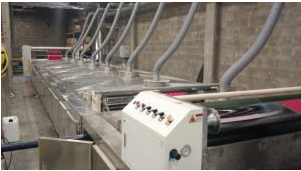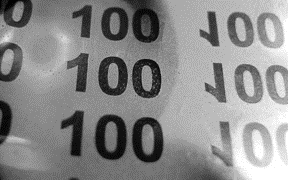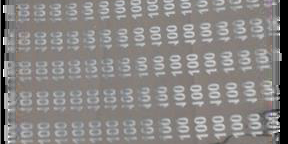This process applies to metallised films (demetallisation) or complexed aluminum sheets (etching). It consists of removing metal zones in a targeted way and thus making the film transparent. This singularity makes it possible to combine metallised printing elements with transparent areas.
PROCESS DESCRIPTION: ROLL TO ROLL MACHINE
In order to understand the operation of demetallisation, the machine can be divided into different blocks:
⇒ An unwinder : it can accommodate coils of different widths and can be composed of guide cells for more precision.
⇒ Chemical tank : they are identical (volume, area) and they are covered with air extractors to avoid being in contact with vapors. A resistance is present in each of the tanks, allowing the heating of this chemical bath in order to make it more active.
⇒ A forced air oven with return : this type of oven allows a slow and total drying. It is a resistance which ensures the heating and which allows the evaporation of the residual water.
⇒ A winder : it can also be composed of a guide cell.
To summarize, after coating the metallised parts which are to be preserved, the film is immersed in several successive chemical baths so that the medium attacks the unprotected metal. The film is then rinsed and dried. It is therefore important to note that the better the coating of the protective varnish, the better fineness of the demetallisation.
BATH TEMPERATURE / MACHINE SPEED : KEY PARAMETERS TO BE MASTERED
The speeds are different depending on the optical density of the metallisation or the thickness of the aluminum foil, the type of film and the application (demetallisation or positive or negative etching). But this parameter is not the only one to master perfectly to obtain the best fine details possible during the process. It is also necessary to control in parallel the temperature of the bath. It is indeed good to remember that the higher the temperature of the solution, the more aggressive the environment will be.
It is therefore only by playing on its two parameters at the same time that it will be possible to obtain an excellent demetallisation :
⇒ : Low bath temperature and High machine speed = for the lowest thicknesses
⇒ : High bath temperature and slow machine speed = for the highest thicknesses.

APPLICATIONS
This chemical process is used to give metallised films or complex aluminum sheets, a technical function and/or an aesthetic appearance. We can now obtain a positive demetallisation (the inscriptions appear metallised on a transparent background) or negative (the inscriptions appear transparent on a metallic background), which makes it possible to bring a visual and aesthetic side to the various supports in the fields of luxury, safety, food packaging etc. It is also possible to combine this process with printing (flexography or gravure printing) or even to laminate the “demetallised” film with another support in order to modify certain characteristics such as the values of barriers, seal ability, conductivity, …

Mickaël Reynier , R&D

